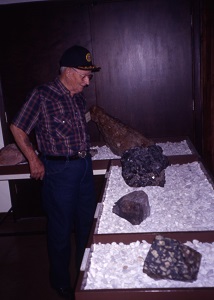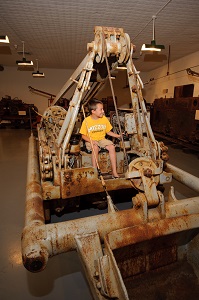Tour the 19,000-square-foot powerhouse, built in 1907 and renovated in the 1980s, as a Missouri mining history and mineral resources museum with two galleries currently open to visitors. Click here for tour fees.
The Mining Equipment Gallery
The first gallery contains underground mining equipment used at various times throughout the long history of the Old Lead Belt. Equipment on display ranges from a small 1-ton ore car to a massive 15-ton electric trolley locomotive.
Most important is a rare St. Joe Shovel, essentially a mechanical loader on crawler tracks. The shovel was designed by the St. Joseph Lead Co. and engineered to the specific underground conditions in the Old Lead Belt. Only 52 were made, the first about 1922.
Another visitor favorite is the speeder, a small man-carrier that provided fast and convenient underground transportation for professional staff and maintenance personnel.
Near the southwest corner of this gallery is a small display of the most important ore minerals -- galena, sphalerite and chalcopyrite -- from the mines in the Southeast Missouri Lead District. There are also equipment and history displays on early mining techniques.
The Mineral Gallery
 The second museum gallery includes exhibits on Missouri geology and mineral resources, and features an outstanding mineral collection. The gallery boasts 27 large cases of mineral specimens, designed not only to showcase the many spectacular crystals, but also to educate. About 1,100 specimens from worldwide localities are on display. Sixteen of the cases are antique display cabinets, custom made in the 1920s for the Missouri State Museum inside the Capitol. The elegant massive hardwood cases, now renovated with modern light boxes, fit well within the old powerhouse interior.
The second museum gallery includes exhibits on Missouri geology and mineral resources, and features an outstanding mineral collection. The gallery boasts 27 large cases of mineral specimens, designed not only to showcase the many spectacular crystals, but also to educate. About 1,100 specimens from worldwide localities are on display. Sixteen of the cases are antique display cabinets, custom made in the 1920s for the Missouri State Museum inside the Capitol. The elegant massive hardwood cases, now renovated with modern light boxes, fit well within the old powerhouse interior.
Six double-sided cases house the museum's systematic mineral collection, an excellent learning exhibit that includes some notable old samples from classic localities. Seven other large cases are devoted to common mineral species or mineral groups, including quartz, calcite, barite, iron oxides, and copper minerals. The fluorescent mineral room -- featuring mineral specimens that "glow" with brilliant colors under ultraviolet black light -- is a favorite with children. Also popular is the lapidary exhibit: a partially backlighted display showcasing transparent mineral specimens, colorful agate varieties and semiprecious gemstones.
The heart of the mineral collection was originally assembled and owned by Fayette P. Graves, a local mining company executive. Graves began collecting as a young man in 1866, and by the turn of the century had assembled what was undoubtedly the finest mineral collection in Missouri -- about 3,000 well-chosen specimens from all over the world. Minerals were self-collected from the local lead mines, purchased from prominent dealers of the day, and traded from other collectors and museums. For years, the Graves' collection was shown in a small company-owned museum in the town of Doe Run. The St. Joseph Lead Co. assumed legal ownership of the collection around 1912 and donated it to the state of Missouri in 1923.
The balance of the Missouri Mines mineral gallery is devoted to basic teaching exhibits. Educational displays depict the physical properties of minerals, crystallography and the environments of mineral formation. Regional exhibits illustrate the geology of Missouri and characteristic rock types, mineral resources of Missouri and typical ore samples, Keokuk-type geodes from northeastern Missouri and igneous rocks of the St. Francois Mountains. Visiting collectors find the Missouri's Own case especially interesting. It contains good examples of the official state rock and mineral: mozarkite and galena. Also featured are typical specimens of other minerals that can be collected in the "Show-Me" state: drusy quartz, Missouri lace agate, bladed barite, limonite and geodes.
A small theater or orientation room at the south side of the mineral gallery is used to show a 12-minute video depicting historic underground mining and ore milling in the Old Lead Belt. The mineral gallery also houses a museum shop, where related books, mineral and fossil samples, mineral jewelry, rockhound equipment, and souvenirs may be purchased.
Future Development
The mineral gallery will be expanded to include a Hall of Missouri Minerals. Twenty or more display units will showcase a definitive collection of the state's minerals, arranged according to mining district and geologic occurrence. Exhibit development is expected to be a long-term project, requiring a number of years. This webpage will be kept up to date with announcements of any significant museum additions or changes.
Park Hours
Weather
Coordinates
37.837778, -90.508611








